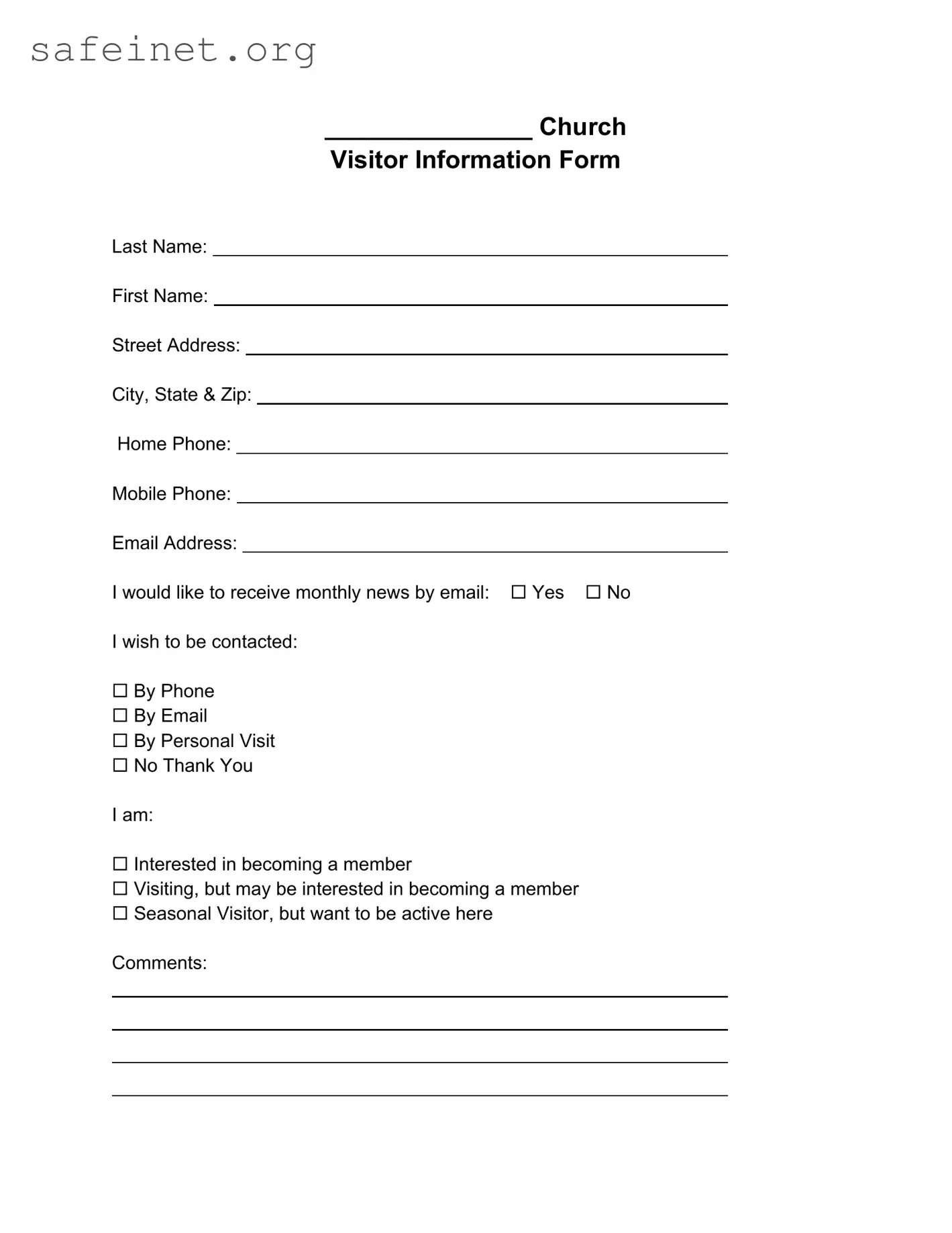The Church Visitor form bears similarities to the Membership Application form often used by organizations and clubs. Both documents collect personal information such as names, contact details, and addresses. This information serves to initiate an engagement process with potential members. Each form also includes sections that allow individuals to express their interest level—whether they are fully committed or merely exploring membership. This helps organizations tailor their outreach and support to address specific needs.
Another comparable document is the Volunteer Registration form. Like the Church Visitor form, it requests basic demographic information, including name and contact details. Individuals who fill it out typically indicate their interests or specific areas where they wish to contribute. By identifying these preferences, organizations can effectively connect volunteers with suitable opportunities that align with their skills and passions, fostering greater involvement.
The Event Registration form is similar in that it gathers essential personal information from attendees interested in participating in specific events. Much like the Church Visitor form, it asks for contact information and may include questions about dietary preferences or special needs. This information helps organizers plan events that cater to the attendees' requirements, ensuring a positive experience for everyone involved.
The Feedback Form shares a resemblance to the Church Visitor form as it allows people to provide input on their experiences. While the Church Visitor form seeks to gauge interest in membership, the Feedback Form inquires about satisfaction levels and suggestions for improvement. Both forms are designed to enhance engagement by acknowledging individual perspectives and ensuring that organizations can respond appropriately.
The Inquiry Form often utilized by educational institutions is similar as it collects information from prospective students or participants. Like the Church Visitor form, it invites individuals to share their contact details and specific interests. This information serves as a foundation for follow-up communication, allowing schools to tailor their outreach to meet the needs of potential students.
The Customer Contact Form is akin to the Church Visitor form because it is designed to gather essential information from prospective customers. Both documents typically request names, phone numbers, and email addresses, focusing on establishing a relationship. This initial data collection helps organizations reach out effectively, providing information on products or services that may interest the individuals involved.
The Membership Renewal form, which is often used by various organizations, resembles the Church Visitor form by collecting contact information and confirming ongoing interest. Just as the Church Visitor form assesses potential engagement, the Membership Renewal form reaffirms a member’s desire to continue their involvement. This ensures that organizations can maintain updated records and tailor communications based on the members' responses.
Another document that aligns closely with the Church Visitor form is the Newsletter Signup form. Both forms request basic contact information to facilitate future communications. While the Church Visitor form focuses on potential membership, the Newsletter Signup form aims to cultivate ongoing engagement by delivering relevant updates and information to interested individuals.
The Survey Form often shares characteristics with the Church Visitor form in terms of gathering information. Both documents collect personal details and responses to specific inquiries. The Survey Form may explore interests or satisfaction levels, paralleling how the Church Visitor form assesses interest in membership. The information collected from both forms helps organizations refine their outreach and improve their offerings.
Lastly, the Donation Form reflects similarities with the Church Visitor form by collecting information from individuals engaged with the organization, albeit from a financial support perspective. Both forms capture personal details and express intent—whether it's to join the organization or to contribute financially. They both aim to foster a sense of connection and purpose within the community they serve.

